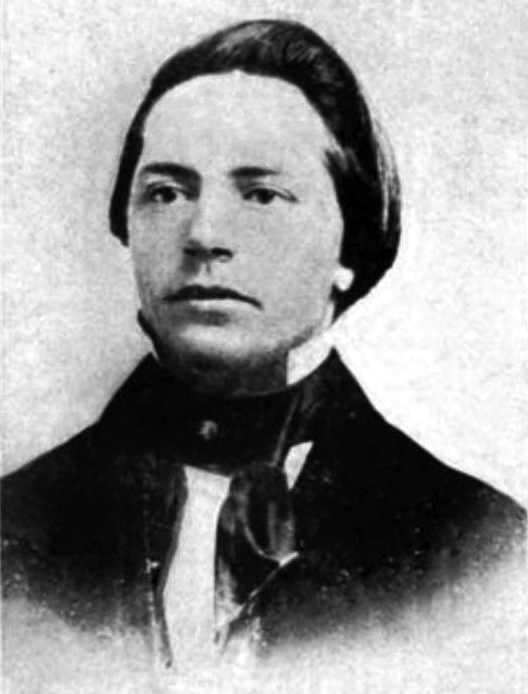This column by Daniel G. Clark about Alexander Clark (1826-1891) first appeared in the Muscatine Journal
October 16, 1859—John Brown led a raid on the federal arsenal at Harpers Ferry, Virginia. His arrest and trial are big news, his December 2 execution high drama.
December 16—Edwin Coppoc of Iowa executed along with three fellow raiders.
(Note: All quotations from the Muscatine Journal of 1859. Coppock and Coppic are deemed less common spellings.)
October 28: “Lieut. Coppic…is a young Quaker from the Springdale neighborhood, in Cedar county, where old Brown himself was quartered several weeks in the summer of 1858 with a number of runaway slaves. We doubt very much, however, whether the staid Quakers of Springdale approve the rash doings of Brown and Coppic at Harper’s Ferry.”
November 19:
Mr. E.C. Martin, a citizen of this vicinity, who is well acquainted with young Coppic, now condemned to death in Virginia, was in our office this morning…. He says he knew Coppic when he was engaged in running a threshing machine in this county about two years ago, and a more industrious and high minded young man could not be found. At that time he was not regarded as a fanatic on the slavery question. He probably became converted to the ultra ideas entertained by Old Brown at the time the latter made a protracted visit to Springdale (Coppic’s home), in Cedar county, during the winter of 1857-’8. … Young Coppic’s mother (his father died when he was quite young) is now the wife of Joseph Raley, a respectable and esteemed citizen of Springdale.
November 21, Edwin addressing the court:
I never committed any treason against the State of Virginia. I never made war upon it. I never conspired with anybody to induce your slaves to rebel, and I never even exchanged a word with one of your servants. What I came here for I always told you. It was to run off slaves into a Free State and liberate them there. This is an offense against your laws, I admit, but I never committed murder.— When I escaped to the engine house, and found the Captain [Brown] and his prisoners surrounded there, I saw no way of deliverance but by fighting a little. If anybody was killed on that occasion, it was in a fair fight. I have, as I said, committed an offense against your laws, but the punishment for that offense would be very different from that which you are going to inflict on me now. I have no more to say.
November 28:
We learn, from a source in which we place the fullest reliance, that Mrs. Raley, of Springdale, Cedar county, the mother of Edwin and Barclay Coppic, both of whom were engaged in the Harper’s Ferry affair, has received a letter from the latter, now in Canada. He says eleven of his companions escaped with him after the battle, and all are now safe in Canada. Four of them were wounded—one so severely that his comrades were obliged to carry him most of the time for the first four days of their flight. Barclay Coppic is one of a number for whose arrest Gov. Wise offered a reward of $500 each.
December 16—Edwin’s execution day—Ann L. Raley letter reprinted from the Davenport Gazette:
As to my house being a depot for the afflicted and suffering, I may inform [the editor] that we have not altogether that honor, as there are many of the neighbors who wish to participate in the generous attention. … [My] eldest son is in a Southern jail, about to be offered up as a willing sacrifice to his country, not for the dark crimes for which he has been condemned, but for defending the great cause of Freedom. The second is in Queen Vic’s dominions…ready to do anything for the great Cause. The youngest is at home attending to school, except when the calls of humanity, as before alluded to, claim his attention. … I am proud to say that I have endeavored to implant the seeds of the great principles of humanity in the minds of my children, and am truly thankful to the great Author of my being that those seeds have taken root and are springing up and producing the fruits which may in time repay the labor.
You can find many stories of John Brown in Iowa, 1855-1859. I recommend “John Brown among the Quakers” by Muscatine-native author Irving B. Richman (first version in the Annals of Iowa, 1866).
John Brown was, arguably, the most famous—or notorious—American of his day. Hero or lunatic. Freedom fighter or terrorist. Prophet or provocateur. The story gets personal for me on several levels.
Oct. 16, 2009—I stand with scholars and fellow history buffs inside the engine house at the confluence of the Potomac and Shenandoah rivers; the building made historic 150 years before, subsequently known as John Brown’s Fort.
Next time: Train ride to Harpers Ferry
Top image: Edwin Coppoc, public domain via Wikipedia.

